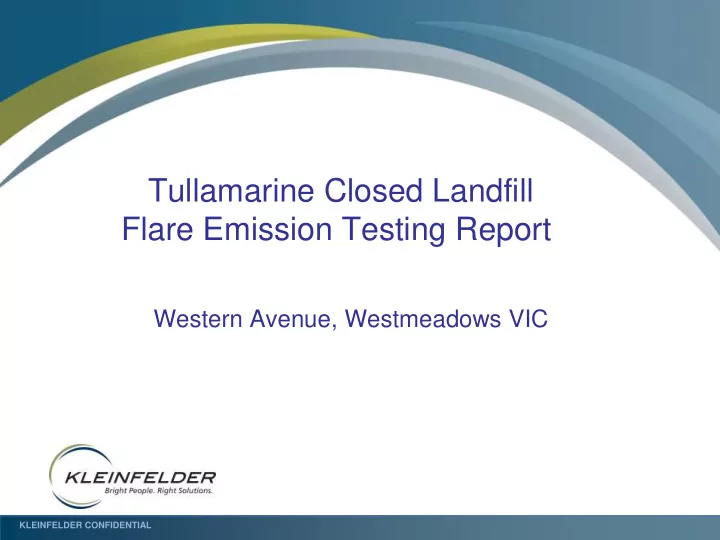

Tullamarine Closed Landfill Flare Emission Testing Report Western Avenue, Westmeadows VIC KLEINFELDER CONFIDENTIAL
Purpose of this Presentation: Present the findings of the Kleinfelder 2015 Flare Emission Testing Report; Provide some context for this report in terms of Landfill Gas management at the site. KLEINFELDER CONFIDENTIAL
Works Undertaken by Kleinfelder: Review of flare outlet analytical data; Screening of data against assessment criteria; Reporting of findings. KLEINFELDER CONFIDENTIAL
Background to Gas Collection and Flaring KLEINFELDER CONFIDENTIAL
Background to Gas Collection and Flaring KLEINFELDER CONFIDENTIAL
Background to Gas Collection and Flaring Emissions Combustion occurs within fully enclosed chamber (900 o C, >0.6 sec residence) Under vacuum provided by LFG from the landfill ‘blower’ KLEINFELDER CONFIDENTIAL
Kleinfelder 2015 Flare Emission Testing Report: Flare Sampling Completed by Ektimo in 2015; (compliant with EPA Publication 440.1 – A Guide to the Sampling and Analysis of Air Emissions and Air Quality) Analysis Completed by Ektimo, Australian National Measurement Institute (ANMI) and EnviroLab; Review of Quality Assurance / Quality Control completed by Kleinfelder. KLEINFELDER CONFIDENTIAL
Regulatory Framework Two State Environmental Protection Policies (SEPPs) are applicable to this assessment: Air Quality Management SEPP (2001) and Ambient Air Quality SEPP (1999). Ambient Air Quality SEPP adopts requirements of the National Environment Protection (Ambient Air Quality Measure 2003 (NEPM). KLEINFELDER CONFIDENTIAL
According to the SEPPs, the following beneficial uses are to be protected throughout Victoria: Life, health and well-being of humans; Life, health and well-being of other forms of life, including the protection of ecosystems and biodiversity; Local amenity and aesthetic enjoyment; Visibility; The useful life and aesthetic appearance of buildings, structures, property and materials; and Climate systems that are consistent with human development, the life, health and well-being of humans, and the protection of ecosystems and biodiversity. KLEINFELDER CONFIDENTIAL
Assessment Criteria: Air Quality Indicators defined as the Following Classes: Class 1 – Common Air Pollutants. Have many sources and can be widespread in the air environment; Include nitrogen dioxide, sulphur dioxide, carbon monoxide, PM10 and lead. Class 2 – Hazardous Substances. May threaten air beneficial uses based on toxicity, bioaccumulation or odour; Generally source specific however can also be widespread. Class 3 – Extremely Hazardous Substances. Highly toxic or highly persistent; Will almost always be restricted to local area around a source. Unclassified – Substances considered to impact local amenity and aesthetic enjoyment only. KLEINFELDER CONFIDENTIAL
Assessment Criteria: Sourced from the Air Quality Management SEPP; Odour based criteria for 17 of the analytes monitored; Toxicity based criteria for 50 individual analytes and two chemical group mixtures (TEQs): Dioxins and Furans; Polycyclic Aromatic Hydrocarbons (PAHs). KLEINFELDER CONFIDENTIAL
Results of Flare Emission Testing: 80% of analytes tested for were not detected in either of the two samples collected; Six analytes exceeded the air quality criteria (3% of those tested): Concentration (mg/m 3 ) Criteria Analyte Class Test 1 Test 2 (mg/m 3 ) (120 min) (120 mins) Acetaldehyde (only odour criteria Class 2 (odour based) 0.0076 0.16 0.18 exceeded) Chromium Class 2 0.017 0.015 0.051 Chlorine Class 2 0.1 0.12 0.1 Total particulate matter Unclassified 0.05 2.6 5.8 Sulphur dioxide Class 1 0.45 <0.2 1.7 Sulphuric acid Class 2 0.033 2.1 1.6 KLEINFELDER CONFIDENTIAL
Comparison to Vehicle Emissions: Note: units are in kg/m 3 ; our assessment is at the mg/m 3 level. Our SO 2 = 0.0000017 kg/m 3 . Our Total Particulate Matter = 0.0000058 kg/m 3 . Annual calculated emissions of a diesel utility (CO, NO x , and PM only) = 330kg/year. Using the same compounds and operating at 200 m 3 /hour, emissions from the flare = 107 kg/year. Dept. Environment, Water Heritage and the arts National Pollutant Inventory (NPI 2008). KLEINFELDER CONFIDENTIAL
Where to from Here? Our assessment focuses on emissions from a source (flare); And conservatively screens against air quality criteria; Some analytes did not have applicable assessment criteria; And six analytes exceeded our screening criteria; Full assessment would consider source (completed), transport pathway and potential receptors. It is understood Transpacific will undertake further assessment (Transport Modelling; Ambient Air Sampling) KLEINFELDER CONFIDENTIAL
Questions? References : Australian Government, Department of the Environment, Water, Heritage and the Arts, 2008, National Pollutant Inventory, Emission Estimation Technique Manual for Combustion Engines Version 3.0, June 2008. Ferreira, A. P., 2013, Levels of Organochlorins Contaminants of Fish Species from Coastal Area in the South Eastern Brazil, International Journal of Marine Science, May 2013. Silberberg, M. S., 2003, Chemistry The Molecular Nature of Matter and Change 3 rd ed, Mc Graw Hill, 2003. KLEINFELDER CONFIDENTIAL
Recommend
More recommend